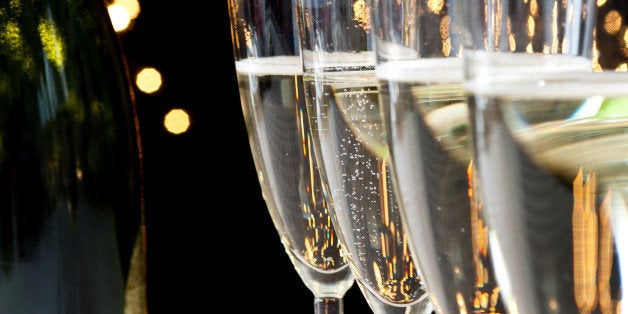
Champagne and sparkling wine are beverages that evoke thoughts of celebration, success, luxury, love and romance. During the holidays, these pleasant associations are even stronger, especially since these beverages have different levels of sweetness. A hostess can use wine as an aperitif or a versatile accompaniment to hors d'oeuvres such as salty nuts, cheese, lightly-spiced fish, Asian dishes, strawberries and more.
Only sparkling wine from the Champagne region in France may legally be called Champagne -- others must be called sparkling wine, prosecco, or cava. But that doesn't diminish their deliciousness or their popularity.
In 2014, California had more than 80 producers and shipped 9.4 million cases of sparkling wine/champagne to U.S. markets. Total U.S. and foreign-produced sparkling wine/champagne shipped to the U.S. in 2014 was 19.7 million cases. The category holds a 5.2 percent share of the U.S. wine market.
Top 10 States for Consumption of Sparkling Wine/Champagne in 2014:
(9-liter cases; Source: 2014 The Beverage Information Group)
1. California: 3,813,700
2. Illinois: 1,920,200
3. New York: 1,685,400
4. Florida: 1,311,900
5. Texas: 1,064,900
6. Michigan: 878,700
7. New Jersey: 702,600
8. Pennsylvania: 519,500
9. Massachusetts: 515,400
10. Ohio: 415,800
1.The History of Champagne: Champagne, once traditionally served only at the coronation of French kings, is now strongly associated with New Year's Eve festivities around the world. The beverage was reputed to have been invented in the 1600s by the monk Dom Perignon. He discovered that the best Champagnes were made from blends of the Champagne grapes (Pinot Noir, Pinot Meunier and Chardonnay) from different vineyards in the Champagne region, north of Paris.
2.Bubbly Personality: Champagne is still-wine that has had sugar added and has been through a second fermentation, and it is this that leads to its effervesce. The smaller and faster the bubbles, the finer the champagne. Scientists have determined that there are 95 million bubbles in a bottle of champagne!
3.Corkage Etiquette: Opening the bottle the proper way will ensure you avoid creating a spray, injuring someone with the cork, or spilling a drop of this precious liquid! It is best to hold the bottle at a 45 degree angle, grasp the champagne cork gently with the one hand and turn the bottom of the bottle firmly with the other hand. Be sure to twist the bottom of the bottle slowly, until you feel the cork gently release in your hand.
4.Sabering Champagne: Legend has it that Napoléon's mounted artillery officers started the trend of sabering. While riding a horse, these soldiers used a blade to cut the top off a champagne bottle with the cork still attached to it. This dramatic presentation requires precise preparation, and is often used for show today by experienced wine connoisseurs. The bottle must rest upside down for 60 minutes in ice so that it's very, very cold. The swordsman removes the bottle from the ice, slowly turns it upright so that it's at a 45 degree angle with no fluid touching the cork. He or she touches the blade to the shoulder of the bottle, then uses a follow-through movement with the blade -- using the elbow; not the wrist -- to remove the cork quickly. While sabering a bottle can seem glamorous, it is also very dangerous and is not recommended unless you're a professional. In addition to losing life and limb, you could also end up with shattered glass in your Champagne!
5.Toasting Etiquette: Clinking your glass is optional. If you're a guest, you may choose to clink or not to clink depending on the hosts and other party-goers. If you're a host, the best rule is to be sure the guests are happy. Avoid comments such as, "I don't clink," because this might causes those wanting to clink their glasses to feel uncomfortable. As always, the most important rule of etiquette is to ensure that others feel comfortable in your presence. Cheers! Salute!